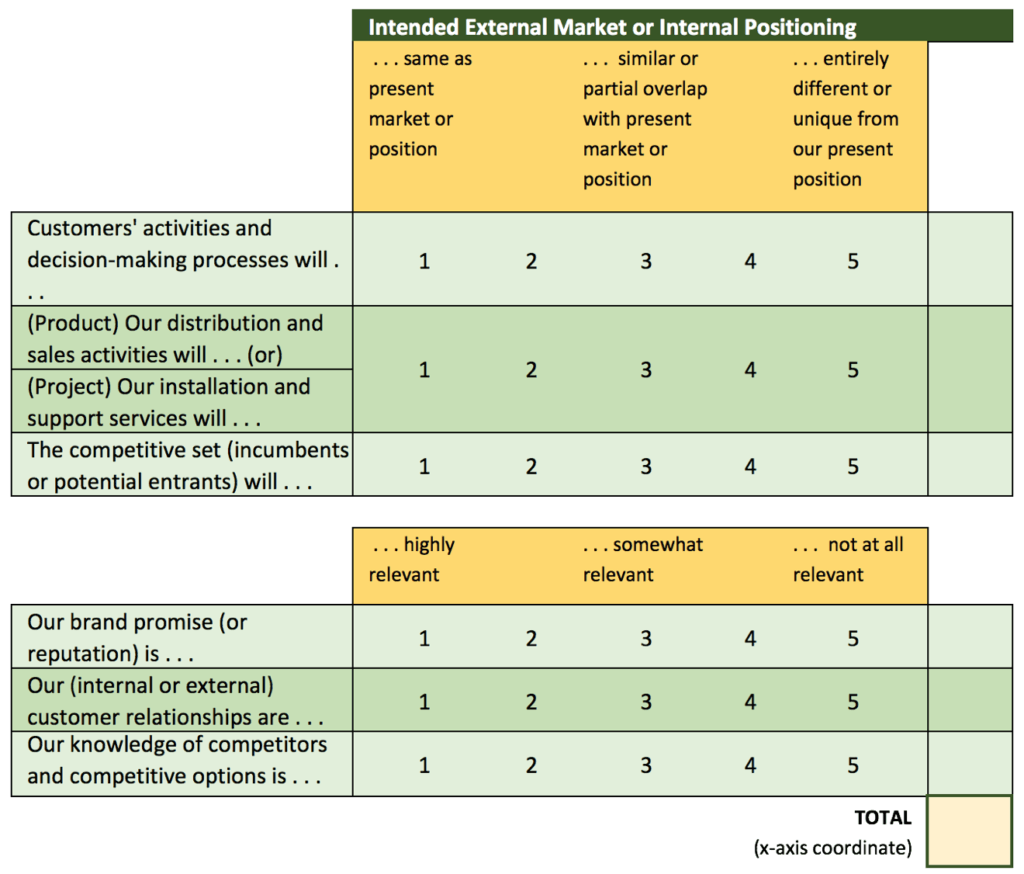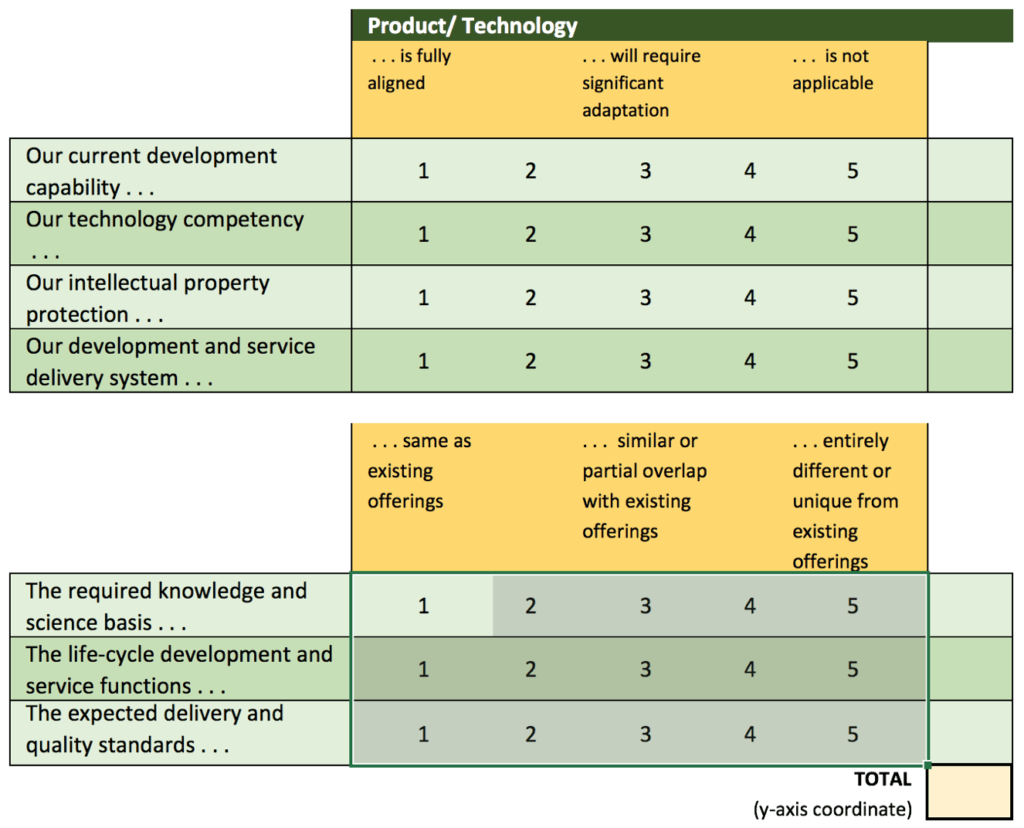Project portfolios focused on the best opportunities, and accelerate innovation. So how do you build consensus around the term “best”? George Day’s article[1] provides excellent logic to help you drive a consensual view of risk analysis.
“The risk analysis matrix employs a unique scoring system and calibration of risk. It helps estimate the probability of success or failure for each project based on how big a stretch it is for the firm.”
Risk analysis tells us that “best” is a function of something. The two main vectors identified by Day include the intended market (x-axis) and the product or technology (y-axis). The charts below show the ranges. Both axis range from “Same” to “New” to the company. Since each question to be asked (below) yields five points, the x-axis extends 30 points with six questions and the y-axis extends 35 points with seven questions.
We modified Day’s original questions that were biased toward product development. Therefore, while product development represents one type of project, we have expanded the rhetoric to embrace various project types. Modify the questions further and adapt them to your own situation.
The Risk Analysis Matrix
A project’s position on the matrix is determined by its score on a range of factors, such as how closely the behavior of intended customers will match existing customers (internal or external). Thus, consider how relevant the company’s brand or reputation may affect the intended market and how applicable its technology capabilities are to develop and provide life-cycle services.
Assessing Risk Analysis Across an Innovation Portfolio


Product/ Technology
Take Time To MODIFY
Providing a set of questions relevant to every reader requires broad and less meaningful phrasing. Therefore, take time to modify the questions above to reflect your personal environment, market conditions, and constraints. You might even expand or contract the number of questions to more fully embrace your project parameters and culture. Remember that the key to building consensus is getting a group of people to focus on the same thing at the same time. Additionally, never underestimate the value of sharp and appropriate questions to drive consensus.
Begin to interpret
A portfolio review team—typically consisting of senior managers with strategic oversight and authority over development budgets and allocations—conducts the evaluation, with input from each project’s development team. Team members may rate each project independently and then explain their rationale. Or, time permitting, conduct a facilitated workshop to build consensus around each factor and score.
Drive consensus by isolating reasons for any differences of opinion and appealing to evidence and your organizational holarchy. The determination of each score requires deep insights. The resulting scores serve as a project’s coordinates on the risk matrix. According to Day:
“When McDonald’s attempted to offer pizza, for example, it assumed that the new offering was closely adjacent to its existing ones, and thus targeted its usual customers. Under that assumption, pizza would be a familiar product for the present market and would appear in the bottom left of the risk matrix. But the project failed, and a postmortem showed that the launch had been fraught with risk: Because no one could figure out how to make and serve a pizza in 30 seconds or less, orders caused long backups, violating the McDonald’s service-delivery model. The postmortem also revealed that the company’s brand didn’t give “permission” to offer pizza. Even though its core fast-food customers were demographically similar to pizza lovers, their expectations about the McDonald’s experience didn’t include pizza.”
Once completed. . .
. . . the risk matrix typically reveals that:
- Organizations have more projects than they can manage well, and
- A majority of projects cluster in the bottom left quadrant of the matrix, and a minority skew toward the upper right, where impactful innovation occurs.
Expect an imbalance between incremental improvements and breakthrough innovation. Discounted cash flow analysis and other financial yardsticks for evaluating development projects are usually biased against the delayed payoffs and uncertainty inherent in massively innovative projects. Again from Day:
“What’s more, minor projects tend to drain R&D budgets as companies struggle to keep up with customers’ and salespeople’s demands for a continuous flow of incrementally improved products.”
The risk matrix provides a compelling and structured visual display to stimulate facilitated discussion. Professionally facilitate discussions and dialogue about the mix of projects and fit with strategy and risk tolerance. Next take a deeper dive into what we cover in our next article, on Real-Win-Worth (R-W-W). R-W-W develops a closer look at each project’s prospects and according to Day represents:
“ . . . a disciplined process that can be employed at multiple stages of product development to expose faulty assumptions, gaps in knowledge, and potential sources of risk, and to ensure that every avenue for improvement has been explored.”
______
Don’t ruin your career by hosting bad meetings. Sign up for a workshop or send this to someone who should. MGRUSH workshops focus on meeting design and practice. Each person practices tools, methods, and activities daily during the week. Therefore, while some call this immersion, we call it the road to building high-value facilitation skills.
Our workshops also provide a superb way to earn up to 40 SEUs from the Scrum Alliance, 40 CDUs from IIBA, 40 Continuous Learning Points (CLPs) based on Federal Acquisition Certification Continuous Professional Learning Requirements using Training and Education activities, 40 Professional Development Units (PDUs) from SAVE International, as well as 4.0 CEUs for other professions. (See workshop and Reference Manual descriptions for details.)
Want a free 10-minute break timer? Sign up for our once-monthly newsletter HERE and receive a free timer along with four other of our favorite facilitation tools.
______
With Bookmarks no longer a feature in WordPress, we need to append the following for your benefit and reference
- 20 Prioritization Techniques = https://foldingburritos.com/product-prioritization-techniques/
- Creativity Techniques = https://www.mycoted.com/Category:Creativity_Techniques
- Facilitation Training Calendar = https://mgrush.com/public-facilitation-training-calendar/
- Liberating Structures = http://www.liberatingstructures.com/ls-menu
- Management Methods = https://www.valuebasedmanagement.net
- Newseum = https://www.freedomforum.org/todaysfrontpages/
- People Search = https://pudding.cool/2019/05/people-map/
- Project Gutenberg = http://www.gutenberg.org/wiki/Main_Page
- Scrum Events Agendas = https://mgrush.com/blog/scrum-facilitation/
- Speed test = https://www.speedtest.net/result/8715401342
- Teleconference call = https://youtu.be/DYu_bGbZiiQ
- The Size of Space = https://neal.fun/size-of-space/
- Thiagi/ 400 ready-to-use training games = http://thiagi.net/archive/www/games.html
- Visualization methods = http://www.visual-literacy.org/periodic_table/periodic_table.html#
- Walking Gorilla = https://youtu.be/vJG698U2Mvo

Terrence Metz, president of MG RUSH Facilitation Training, was just 22-years-old and working as a Sales Engineer at Honeywell when he recognized a widespread problem—most meetings were ineffective and poorly led, wasting both time and company resources. However, he also observed meetings that worked. What set them apart? A well-prepared leader who structured the session to ensure participants contributed meaningfully and achieved clear outcomes.
Throughout his career, Metz, who earned an MBA from Kellogg (Northwestern University) experienced and also trained in various facilitation techniques. In 2004, he purchased MG RUSH where he shifted his focus toward improving established meeting designs and building a curriculum that would teach others how to lead, facilitate, and structure meetings that drive results. His expertise in training world-class facilitators led to the 2020 publication of Meetings That Get Results: A Guide to Building Better Meetings, a comprehensive resource on effectively building consensus.
Grounded in the principle that “nobody is smarter than everybody,” the book details the why, what, and how of building consensus when making decisions, planning, and solving problems. Along with a Participant’s Guide and supplemental workshops, it supports learning from foundational awareness to professional certification.
Metz’s first book, Change or Die: A Business Process Improvement Manual, tackled the challenges of process optimization. His upcoming book, Catalyst: Facilitating Innovation, focuses on meetings and workshops that don’t simply end when time runs out but conclude with actionable next steps and clear assignments—ensuring progress beyond discussions and ideas.





With increasing pressure to improve the cost and schedule performance of projects, many organizations now recognize the need to incorporate rigorous cost management and earned-value capabilities into their project management systems.
Enjoyed the article and found it extremely relevant for various types of risk assessment. And yes, the questions can be appropriately modified to suit the project being assessed.
Thank-you kindly Sangeeta for taking the time to read and reply to our discussion on modifying risk assessment to meet your needs. Many read, but few comment–and we greatly appreciate you for the extra effort.